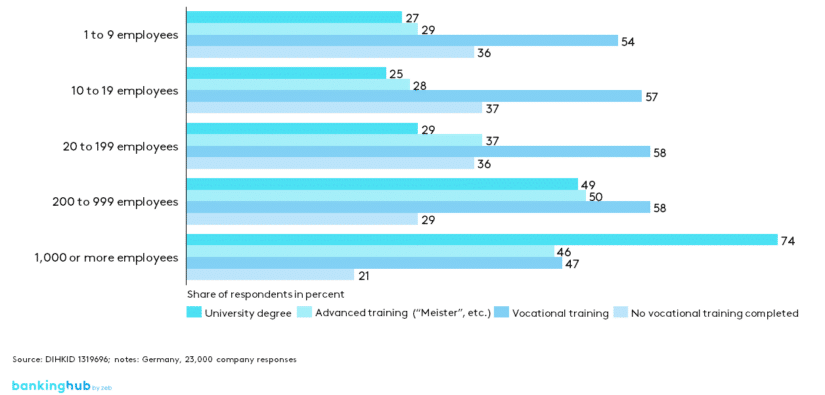What does the labor market situation mean for companies?
Once the Covid restrictions were lifted, the most visible example was the “sudden” shortage of workers in the restaurant industry and at airport security checkpoints. During the pandemic, many people who had worked in those areas found other employment. These outflows could only be partially reversed and continue to lead to shortfalls.
The word “skilled” will have to be deleted from the phrase “shortage of skilled workers”
Like a catalyst, the pandemic accelerated an existing trend: in the future, the labor shortage will be increasingly felt even in areas where no special expertise is required to take up the job.
Simon Jäger, labor market expert and CEO of the Institute of Labor Economics (IZA) in Bonn, recently elaborated on this in an interview[1]:
Because of technological advances, there is more demand for jobs at both ends of the wage scale, i.e. at the high end and the low end. There is greater demand for highly complex jobs, for example software developers, but also in the medical field.
However, there is also an increased demand for very simple service tasks, such as gardening help, i.e. jobs that are very difficult to replace with machines because they are not routine tasks and because each work step is highly individual.
In addition, Jäger observed a
situation where market forces say that in certain areas, work conditions are not attractive enough to provide incentives for people from other fields to switch to. That’s why I expect that things will start moving with regard to wages and working conditions in those areas where we have a particularly pronounced “shortage of skilled workers” at the moment.
Competition for workers
In addition to competing for orders and customers, companies are also competing for workers. When it comes to vacancies with specific requirements regarding qualification as well as professional experience, candidates continue to have free choice and can select from a wide range of positions. It is a “buyer’s market” in which they are almost free to dictate the conditions, and companies are willing to offer more to this target group than to less qualified applicants.
For simpler job profiles and tasks where the requirements are not as high, companies have so far been unwilling to offer any particular benefits. After all, these positions were always easy to fill. At the same time, their share is as high as it has ever been. This is confirmed by a recent study conducted by the German Chamber of Industry and Commerce[2], according to which companies of all sizes unsuccessfully continue to seek employees who do not need to have completed any vocational training. Among small businesses with fewer than 200 employees, up to 36 percent unsuccessfully search for such workers; among large enterprises with more than 1,000 employees, it is still a good fifth.

Fundamental labor shortage and employee turnover
So there is a shortage of skilled workers, but not just a skills shortage, but a fundamental shortage of workers. This is because there are still tasks that cannot be automated (e.g. in facility management) or for which automation is not worthwhile because they need to be performed only rarely or irregularly. In addition, not all tasks can be automated even in the course of digitalization. This may be because legacy systems still contain processes that cannot be adequately mapped in standardized systems at reasonable cost, or because employees have to perform manual checks or simple input tasks within the systems.
Nowadays, candidates for such jobs can also more easily decide what terms they are willing to accept. Because of the low barriers to entry in this segment, it is even easier to change employers.
Offering instead of promising
So companies are learning what it means to operate in a buyer’s market. And another thing they are learning: in the competition for workers, they now really have to offer something and not just promise things like they did in the past. Demands are not limited to wages and working hours. For the highly qualified, important decision-making criteria include the meaningfulness of the tasks, corporate culture, and opportunities for advancement and further training. For the less qualified, the situation is similar. Companies that pay little and offer precarious working conditions will therefore be hard-pressed to find any interested candidates.
Higher salaries are not the solution
Employers who want to be successful in this competition for workers – and not just skilled workers – would be well-advised to think about offering more than just higher salaries.
This is confirmed by a representative survey conducted by the opinion research institute forsa on behalf of XING E-Recruiting among 2,523 employees from Germany, Austria and German-speaking Switzerland in 2022..[3]
According to this survey, the top 5 reasons why employees quit are:
- Leadership behavior (28 percent)
- Better work-life balance (27 percent)
- More attractive field of work (24 percent)
- Financial incentives (19 percent)
- More attractive position (15 percent)
Financial incentives are among the top 5 reasons for quitting, but they only rank fourth. According to the study, leadership behavior and the working environment are much more decisive.
BankingHub-Newsletter
Analyses, articles and interviews about trends & innovation in banking delivered right to your inbox every 2-3 weeks
"(Required)" indicates required fields
Six key areas are becoming important for companies
So for companies, in addition to hiring new employees, it’s also about creating a work environment that can compete with other organizations. Newly recruited workers are of little use if they leave the company again within a short period of time.
Therefore, companies now have to make themselves competitive for all target groups in six core areas:
- Working environment and organization
(e.g. options to work from home, working hours, part-time options, equipment) - Compensation and benefits
(e.g. non-cash benefits, company pension plan, work equipment for private use) - Development and advancement
(e.g. regular feedback, career planning, continuing education, opportunities for advancement) - Employer branding and marketing
(e.g. management of rating portals such as kununu, employee referral programs, social media presence) - Culture and communication
(e.g. corporate and leadership culture, employee survey / engagement survey, transparent communication of goals and values, work-life balance) - Health and leisure
(e.g. corporate health management, health courses and advice, avoidance of overtime, opportunities for a sabbatical)
Only those employers who keep an eye on all these areas and manage them in a targeted manner will still be able to find sufficient employees in the future and retain them in the company in the long term.
Conclusion on labor shortage
In the future, “skilled” should be deleted from the phrase “shortage of skilled workers” because the truth is that there is now a shortage of labor. Companies that want to stay ahead in the competition for workers should not just focus on highly qualified specialists but approach the issue holistically for all (potential) employees.
Attractive employers who have done their homework and actively manage the six key areas mentioned above will have an easier time in the future competing to find sufficient employees and retain them in the long term.




